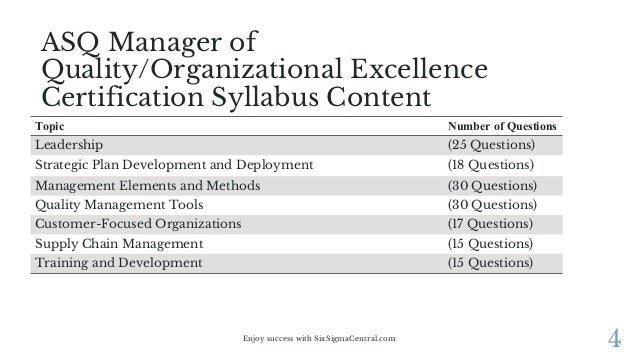Free CMQ/OE Practice Test
1. One impediment to bringing about effective change would be that the subjects being studied may intentionally or unintentionally change their behavior simply because they’re aware they’re being monitored, rather than as a result of any fundamental areas of the experiment. This is called the:

Hawthorne effect
Heisenberg uncertainty principle
Ramsey factor
Godfrey ambivalence scale
CMQ/OE Exam Study Guide with more experience Questions
2. The theories of Abraham Maslow are foundational components of which of the management styles?
Scientific management
Human relations management
Management by objective
Management by results
3. The information management approach where individuals add their knowledge into a common storehouse (for instance a database) works as a:
Communities of practice strategy
Best practice transfer strategy
Codification strategy
Knowledge mapping strategy
4. Six Sigma has five phases (DMAIC), it uses many tools that aren’t a proprietary part of the methodology. Which of the outside tools commonly used in Six Sigma would utilize an Ishikawa diagram?
TRIZ
Taguchi methods
Five Whys
Quality Function Deployment
5. The Rummler-Brache approach to business processes is recognized as the:
Theory of Constraints Model
Nine Boxes Model
Interoperability Model
Seven Circles Model
Answers
1. A: Hawthorne effect. The name arises from studies of workers at a factory called Hawthorne Works in early part of the twentieth century. Case study learned that when workers know they’re being monitored during an asq cmq oe question bank, the results in the experiment are generally different than those achieved by workers getting involved in an identical experiment that are unaware actually being monitored. Sometimes the difference is positive, and sometimes the difference is negative, however, if workers know they’re being observed during an experiment, the results tend to be skewed, this also must be considered.
2. B: Human relations management. Abraham Maslow’s theories are foundational on the hr management style. In Maslow’s 1954 book Motivation and Personality, he proposed that humans are motivated by way of a hierarchy of needs, which many individuals have described as a pyramid. At the end will be the most elementary physical needs, then safety, then love/belonging, then esteem, with self-actualization at the very top. Maslow thought that it’s impossible for those to offer the objective of meeting their more impressive range needs if their lower level needs aren’t already being met.
3. C: Codification strategy. The information management approach where individuals add their knowledge into a common storehouse (for instance a database) works as a codification strategy, or push strategy. The opposite answer choices all instruments or strategies commonly used in knowledge management.
4. C: Five Whys. An Ishikawa diagram, also known as a fishbone diagram, could be included in the Five Whys strategy for addressing the root of your problem. The diagram concept was created by Kaoru Ishikawa, and it is commonly used for product design and defect prevention purposes.
5. B: Nine Boxes Model. The Rummler-Brache approach to business processes is recognized as the Nine Boxes Model. It includes three levels: Organization, Process, and Performer. Each level has three sections: Goals, Design, and Management. The Nine Boxes Model is frequently used in the appearance of employee training programs.
For more info about asq cmq oe question bank check our new site: click here
